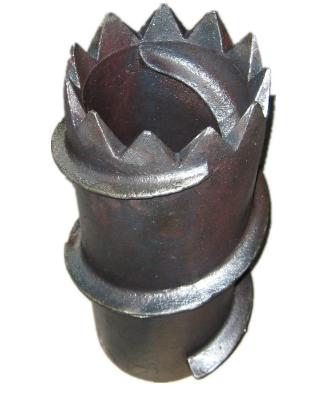Storage state of iron in sand
The storage state of iron in quartz mines determines the extent to which significant achievements can be removed and removed. Therefore, it is first necessary to understand which minerals are present, in what form, in content and their distribution.
The main ore minerals are quartz crystal, in addition, there are a dozen other silicate minerals and metallic minerals, such as hornblende, mica, sphene, epidote, garnet, pyroxene, tourmaline, corundum , calcite and magnetite, hematite, titanium ore and so on. There are also weathered clay minerals. Minerals with unstable chemical properties will be naturally eliminated during rock crushing, weathering and handling, so the minerals in quartz sand are mainly composed of dozens of minerals. In most quartz sands, the content of quartz exceeds 90%. In some high-quality sands, the content can reach 98%~99%. Inferior sand and feldspar sand, its content is only 75% to 80%. The iron content in the quartz sand increases as the particle size decreases. This is because the heavy minerals and feldspars in the fine particles are large, and they are not divided into five forms like the state of quartz. The following explanations are three:
(1) Present in clay minerals. In some sedimentary sand deposits that expose the surface, they contain more weathered clay. This clay is weathered from feldspar, limestone , shale, etc. The clay is a natural aeolian silicate containing a mixture of mica, quartz, limonite, chlorite, calcite and hornblende. . Its particle size is very fine, mainly composed of particles below 10 μm.
(2) It is found in heavy minerals and magnetic minerals. Heavy minerals are minerals that are relatively denser than 2.9. Most of these minerals are magnetic or weakly magnetic, and iron is a basic component of these minerals. So we can also refer to them as being present in monomeric minerals.
(3) Exist in light minerals. Light minerals mainly refer to feldspar (usually feldspar or micro-plagioclase). Aluminum oxide, feldspar sometimes substituted iron oxide in an amount up to 0.5 to 0.7%. In addition, there are kaolinite, muscovite, calcite, dolomite and the like. Among these light minerals, iron enters the crystal in the form of isomorphism, and since their density is very close to that of quartz, it is quite difficult to separate them.
(4) Present in thin film iron. Quartz particles in quartz sand are white in pure condition and are gray, brown, yellow or even red. For example, clay can be gray or yellow, metal minerals and other minerals can make it gray, and thin film iron makes it yellow or red. Most of our usual are iron pollution and muddy pollution. The former refers to the contamination of quartz particles by iron oxides or hydroxides. The latter refers to the clay mineral contamination of a series of layered aluminosilicates. In terms of genesis, it can be divided into primary pollution and secondary pollution. Primary pollution refers to the contamination of its minerals on the surface or inside of a mineral caused by mineral dyeing. Mineral dyeing is a phenomenon in which a certain mineral produces its internal or surface minerals in the form of particles or thin films during mineralization, which is closely related to the mineralization process. There is also a phenomenon of contamination of minerals (or ions) on the surface of quartz particles due to adsorption, which is called secondary pollution.
The contamination of quartz particles by clay minerals is related to the depressions and gaps in the quartz surface and the plasticity of the clay. The clay attached to the surface of the quartz particles is easier to remove because they are not firmly bonded. However, the iron oxide film on the surface of quartz particles is difficult to eliminate, which is caused by mineralization. In fact, the so-called thin film iron mainly refers to this case.
(5) Exist in the continuum or crystal lattice. The various minerals in the quartz sand can basically be considered to be in the state of dissociation of the monomer, so there is no need to apply the fragmentation, but the quartz particles are still associated with other iron-bearing minerals. Most of these continuums are dark minerals, some of which are wrapped in quartz granules, some are embedded in the edges of quartz granules and become mineral aggregates. The so-called wrapped iron mainly refers to this situation.
The state of occurrence of iron in quartz sand can also be classified by other methods. Classified according to the scheme, it can be divided into light minerals (relative density less than 2.9) and heavy minerals (relative density greater than 2.9). According to magnetic classification, it can be divided into non-magnetic minerals and magnetic minerals. According to the symbiotic relationship, it can be divided into single minerals and composite minerals, and so on. Of course, how to classify them is not very important.

we produce a huge range of products and are continually expanding our services to customers. This area shows images of some of our recent work to show the scope available to our clients. This is just a sample of what we can do, so please contact us for more information.
Material:Grey iron
Casting weight range:1-500kgs
Process:casting+CNC Machining
Application:Machinery
Market:Europe,America
Baoding Henglian can supply the following castings
1:grey iron castings:DIN1691-85, GG15,GG20,GG25, GG30,GG35,
2,Ductile iron castings:ASTM A536-84,GRAND 60-40-18,65-45-12,80-55-06,100-70-03
3,Malleable iron castings:DIN1692-82 GTS-35-10
4,carbon steel and alloy steel castings
5,brass castings,bronze castings and aluminum castings

Sand Casting Foundry,Sand Casting,Ductile Iron Casting,Steel Casting
Baoding Henglian Mechanical Co.,Ltd , https://www.hengliancasting.com
![<?echo $_SERVER['SERVER_NAME'];?>](/template/twentyseventeen/skin/images/header.jpg)